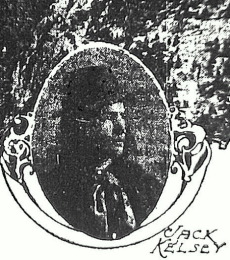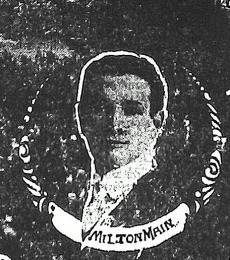San Francisco Chronicle, July 17, 1904, p. 6:
Half Dome, now called Le Conte Half Dome, is the highest point in the wall of Yosemite valley, rising 4972 feet above the floor. It offers difficulties almost insurmountable to a climber, no matter how accomplished. The only possible approach to the dome proper is from the eastern shoulder. After hours of hard climbing, one reaches the base of the crest, which is a great smooth mountain of native granite. The surface is made of overlapping shingles, with no foothold for long stretches and no vegetation to relieve its barrenness (...) Attempts [to climb the dome] were made, but none succeeded until, in 1875, George Anderson (...) reached its summit on October 12th. He accomplished it by the use of drills and a hammer, putting in iron eyebolts and wooden pegs about eight feet apart. He afterwards threaded a rope through eyebolts, and some number of tourists made the ascent without serious difficulty. The rope was partially carried away by sliding snow in the winters following. The pegs have, one by one, rotted away, and now only a few of the iron ones remain. For years it [i.e., Half Dome] has been inaccessible.
On the afternoon of July 3d a flag, appearing as a white speck, was seen on the dome's crest, and also flashes from a mirror. Knots of people gathered in the village street and all over the valley floor to watch and wonder. A few who had been pledged to secrecy knew that the attempt was to be made, but had no thought that it would succeed. By the aid of strong glasses the three heroes could be seen, mere dots against the sky. Several blasts were heard during the evening, and fireworks lasting nearly an hour were seen and a campfire glowed like a star throughout the night. During the afternoon of the Fourth the three returned. They are all Californians in their twenties—hardy, sunburned, and gratified with their daring accomplishment.
Jack Kelsey of the Y. M. C. A. track team of San Francisco tells the story in a matter-of-fact way:
"O. L. Jordan of Whittier and I left the city on May 10th, intending to see the Mariposa Big Tree grove and Yosemite, and to go across the mountains to Lake Tahoe. We planned from the first to climb Half Dome, though we were discouraged by all we talked to. Reaching the valley, we met Milton Main of San Jose, who was equally determined to climb the dome. We joined forces and went together. We sent for fireworks so we could celebrate the Fourth if we gained our point. Two preliminary trials, June 21st and 28th, failed. The freight wagon with the fireworks aboard came late July 2d, and we left that night so as to be well on the way the next morning. We carried about 125 pounds in all, including food, blankets, 190 feet of rope, Roman candles, sky rockets and twenty-one sticks of dynamite. The trail was hard to find in the dark, and Main, who carried the dynamite on this part of the trip, fell twice. We went into camp at the foot of Nevada Fall about midnight".
"Starting at 5:30 o'clock Sunday morning, we had over six hours of continuous scrambling, without water, over the east flank of the mountain to the base of the dome, where the hard work was to begin. There we found a patch of snow and refreshed ourselves with a lunch. Above towered the rounding slope of the dome. It seemed more round and smooth than ever, and the risks we were to run with our load loomed awful. We wrapped the dynamite more carefully in the middle of our roll of blankets. For over a thousand feet we painfully crawled, the dome seeming to rise higher and sheerer. The noon sun beat unmercifully on us, and the rarity of the atmosphere and our exertions gave us again the terrible thirst intensified. The slope [here] was about 45 degrees. We came finally to the wide shelf at the bottom of the last climb. The view had enlarged constantly. We discovered another snow patch on a ledge fifty feet below us on the north face, and the boys let me down by the rope to get a supply. It certainly tasted good. Only 900 feet above us was our goal. We could see a few of Anderson's pegs, but for the most part could discover his path only by the line of holes where the wooden pegs had been. We shed our shoes here, and made our baggage into bundles, going first by turns. We soon found that we made better progress and felt more secure by going backwards[!] The man leading carried the coil of rope on his shoulders, pulled up the rolls of impedimenta, and assisted the others with the rope when he came to a secure footing. The rock seemed continually to try to push us off. The angle [at this section] was fully 60 degrees on an average. A slip meant destruction. The tension was kept high, especially when the lower men tied on the bedding and called out, 'Here comes the dynamite'".


Illustration from the Chronicle's article (1904):
Two daring young men,
Jack Kelsey and Milton Main.
(Lester Jordan was not pictured).
"The same edging-alone process was repeated indefinitely, it seemed. At one
point it appeared that we were doomed to defeat. We slipped back at every
trial. A slope defied our methods and we had to resort to an acrobatic
performance. Main got a firm foothold and lay face to the rock; Jordan
worked his way up and stood on Main's shoulders. Getting on Jordan, after
half an hour, I lassoed an iron peg at least twenty-five feet above, and,
pulling the noose tight, this last obstacle vanished into a proposition of
sliding up hand over hand. When up to the peg we gasped in amazement to
find that it was only loosely set in the hole. Down below bits of rock
which we had loosened bounded and rebounded for minutes, it seemed, before
they rested. But we were safe and we faced ahead. At 3:30 o'clock we were
on the top, and by 4 had sent mirror signals and had received answering
ones from below. We were almost famished for water, but soon had a supply
in a small dam that we made across a trickle from the last bit of last
season's snow".
"We found a space of perhaps seven acres on the top. Two scrub pines manage to exist, and a few lizards and grasshoppers have their homes in this eyrie. On one pine we found carved the name of Thomas Magee with the dates of 1877 and 1895. We left ours besides his. The view I could not describe if I had hours in which to do it. Yosemite has no equal in the world, and in Yosemite there is no view equal to this from the peak of the Half Dome. There are higher mountains to be scaled, though few equal this in difficulty, but the sheer abyss of Half Dome's north face cannot be equaled, much less surpassed. Five thousand feet below we could distinguish our fellows. All around us lay an unending panorama".
"We got up our canvas flag at once on a pole which had impeded our climb on the way up. We than gathered wood for our fire and built a windbreak of flat rocks as a shelter from the constant gale. When dinner was over we had left only one can of sardines and some butter, such were our appetites. With the disappearance of the sun our scant supply of water froze and we were forced to eat snow again. What we would have done if that bit of snow had not been there I do not like to imagine. At dusk campfires began to glow in the valley. The Happy Isles road with its row of lights looked like a glowworm wriggling through the night. The hotel took on appearance of an Oakland ferry miles away. We tried our dynamite and were amply rewarded for our risk in bringing it by the echoes resounding back and forth from dome to dome. We followed with Roman candles, skyrockets and red fire, and went to sleep contended with our celebration of the Fourth near the top of the world".
"The trip down was without incident except that we took with us the loose pin lest another party might not fare as well as we. I wouldn't have missed the trip for the world and do not expect to take another while I live that will equal it. I could not advise another to take it. It is a foolhardy climb when all's said and done, though to one who appreciates nature and natural grandeur the risks seem worth the taking".
[Reported by] C. M. Scarborough